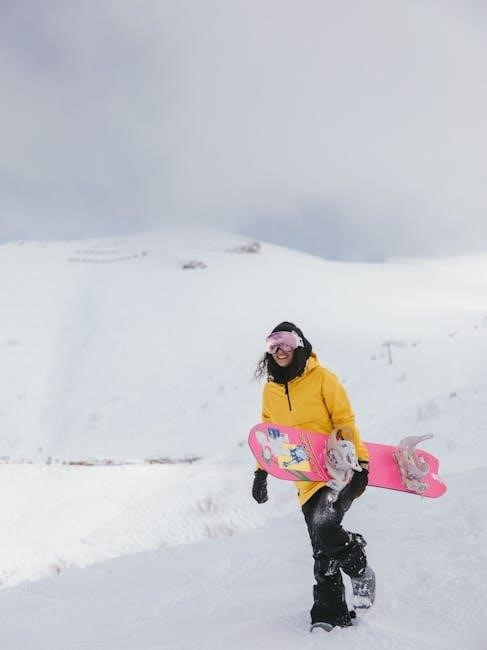Choosing the right ski goggles size is crucial for optimal protection, visibility, and comfort. This guide helps you determine the perfect fit based on your face shape and head size.
Why Proper Fit Matters for Ski Goggles
A proper fit is essential for ski goggles to ensure optimal performance, comfort, and safety. Ill-fitting goggles can lead to reduced visibility, discomfort, and even safety hazards. Protection from elements: Goggles shield your eyes from snow, wind, and debris, but only if they fit securely. Unobstructed vision: A correct fit prevents fogging and ensures a clear field of view, critical for navigating slopes. Comfort during long sessions: Poorly fitting goggles can cause pressure points, distracting you from your skiing experience. Safety: A secure fit keeps goggles in place, preventing them from shifting or falling off during high-speed activities. Investing time in finding the right fit ensures a more enjoyable and safe skiing adventure.
How to Measure Your Head for Ski Goggles
Measuring your head circumference accurately is key to finding the right ski goggles size. Use a flexible tape measure or a string to wrap around your head, just above your eyebrows and ears, keeping the tape level. Ensure the fit is snug but not too tight, as this will mimic how the goggles will sit. If using a string, mark the point where it overlaps and measure the length with a ruler. This measurement will help you choose the correct size from the goggles’ size chart. Proper sizing ensures a secure fit, preventing gaps that could let in snow or cold air. Accurate measurement is crucial for both comfort and functionality, ensuring your goggles perform as intended during your skiing or snowboarding adventures.

Key Factors to Consider When Choosing Ski Goggles
When selecting ski goggles, consider lens type, tint, anti-fog coating, and frame size. Proper fit, ventilation, and compatibility with helmets or glasses are also essential for optimal performance.
Understanding Face Shape and Goggle Compatibility
Understanding your face shape is crucial for selecting ski goggles that fit comfortably and provide optimal visibility. Oval faces, with balanced proportions, suit most goggle sizes. Round faces benefit from narrower frames to elongate the appearance, while square or heart-shaped faces pair well with larger frames to balance angular features. Proper fit ensures goggles stay secure, reducing pressure points and preventing fogging. Measuring key facial dimensions, such as temple width and nose bridge, helps match your face shape to compatible goggle sizes. Ensuring compatibility enhances comfort and performance, making it easier to focus on your skiing experience without distractions.
The Importance of Lens Size and Field of Vision
Lens size and field of vision are critical factors in selecting ski goggles, as they directly impact visibility and performance. A larger lens size provides a wider field of vision, reducing blind spots and enhancing peripheral awareness, which is essential for skiing. However, overly large lenses may not fit securely, compromising comfort and functionality. Smaller lenses, while more compact, can limit peripheral vision, potentially hindering reaction times. The ideal lens size balances visibility with a snug, secure fit. Additionally, a goggle’s frame design should minimize obstruction, ensuring an unobstructed view. Proper lens size and field of vision ensure optimal performance, safety, and comfort, making them vital considerations in your ski goggles selection.
Frame Type and Material: Choosing the Right Pair
Frame type and material play a significant role in the comfort, durability, and performance of ski goggles. Rigid frames offer excellent durability, while flexible frames provide better adaptability to various face shapes. Common materials include polyurethane, known for its flexibility and shock absorption, and ABS, which offers lightweight durability. Some goggles feature a combination of materials for optimal performance. The frame’s design should ensure a snug fit without pressure points, while also accommodating features like ventilation systems. Additionally, the material’s ability to withstand extreme temperatures and impacts is crucial for skiers. Choosing the right frame type and material ensures long-lasting comfort and reliability, making it a key consideration in selecting ski goggles.

How to Determine Your Ski Goggles Size
Determining your ski goggles size involves measuring your head circumference and comparing it to size charts. Proper fit ensures optimal protection, visibility, and comfort while skiing.
Using a Tape Measure for Accurate Head Circumference
To ensure an accurate fit, measure your head circumference using a flexible tape measure. Place the tape around the widest part of your head, just above your eyebrows and ears, keeping it level and snug but not overly tight. Take note of the measurement in inches or centimeters. For the most precise fit, measure twice and average the results. This step is crucial as it directly corresponds to the size charts provided by manufacturers. Proper alignment and tension are key to avoiding discrepancies. Once you have your measurement, compare it to the size chart to determine your ideal goggle size. This method ensures a secure, comfortable fit for optimal performance on the slopes.
Interpreting Ski Goggles Size Charts
Understanding ski goggles size charts is essential for selecting the right fit. These charts typically include measurements for head circumference, lens width, and frame dimensions. Start by locating your head circumference measurement, usually expressed in inches or centimeters. Match this to the corresponding goggle size, which may range from small to extra-large. Pay attention to lens width, as it affects field of vision and compatibility with your face shape. Some charts also specify frame styles, such as medium or large, to suit different head sizes. Ensure your measurements align with the chart to guarantee a secure and comfortable fit. Proper interpretation helps avoid issues like fogging or restricted vision, ensuring optimal performance on the slopes.
How to Ensure a Comfortable and Secure Fit
Ensuring a comfortable and secure fit for ski goggles involves several key steps. First, measure your head circumference accurately to choose the correct size from the size chart. Next, try the goggles on with your helmet or hat to ensure compatibility. Adjust the strap for a snug fit without excessive pressure. Check for any gaps between the frame and your face, as proper sealing prevents wind and cold from entering. Opt for goggles with adjustable straps and soft, breathable foam padding for added comfort. Additionally, consider frame styles that match your face shape and head size. Finally, test the goggles by moving your head to ensure they stay securely in place. A well-fitting pair enhances performance, reduces distractions, and provides long-lasting comfort during your skiing or snowboarding adventures.

Understanding Ski Goggles Lens Options
Choosing the right ski goggle lenses depends on light conditions, with options like tinted, mirrored, or photochromic lenses. Anti-fog coatings and UV protection ensure clarity and eye safety.
Choosing the Right Tint for Different Light Conditions
Choosing the right tint for your ski goggles is essential for optimal visibility in varying light conditions. Darker tints, such as black or gray, are ideal for bright, sunny days as they reduce glare and provide better contrast. Lighter tints, like yellow or amber, are best for cloudy or low-light conditions, enhancing visibility and reducing eye strain. Mirrored lenses offer additional glare protection and are versatile for multiple lighting scenarios. Photochromic lenses adapt automatically to changing light, offering convenience for skiers who experience fluctuating conditions; Proper tint selection ensures clearer vision, improved safety, and enhanced performance on the slopes.
Single Lens vs. Double Lens: What’s Best for You
When choosing ski goggles, deciding between single and double lenses is crucial for performance and comfort. Single lenses are lighter, more affordable, and often used in warmer conditions, but they can fog more easily. Double lenses, featuring an air gap between two panes, provide superior insulation, reducing fogging and offering better temperature regulation. Double lenses are ideal for cold, high-humidity environments, making them a top choice for frequent skiers. However, they are heavier and more expensive. For casual use or warmer climates, single lenses suffice, but for optimal clarity and fog resistance in harsh conditions, double lenses are worth the investment. Consider your skiing frequency and environment to make the best choice.
Anti-Fog Coating: Features to Look For
Anti-fog coatings are essential for maintaining clear vision during skiing. Look for goggles with hydrophobic or chemical-based coatings that repel moisture and prevent fog buildup. These coatings ensure consistent visibility, even in humid or high-exertion conditions. Additionally, some goggles feature double lenses, which create an insulating air gap to further reduce fogging. When shopping, check for durable coatings that withstand repeated use and cleaning. Avoid goggles with coatings that degrade quickly, as this can compromise their anti-fog performance. Proper maintenance, such as avoiding harsh chemicals and not wiping the lens excessively, can extend the coating’s lifespan. Prioritize goggles with robust anti-fog technology to enhance your skiing experience and safety on the slopes.

Additional Features to Consider
Consider ventilation systems for reduced fogging, interchangeable lenses for adaptability, and OTG compatibility for wearing over glasses. These features enhance comfort and functionality for optimal skiing performance.
Ventilation Systems for Reduced Fogging
Ventilation systems in ski goggles are essential for reducing fogging, ensuring clear vision during active use. Dual-lens designs create a thermal barrier, minimizing moisture buildup. Strategic vent placement allows air to circulate, evaporating sweat and preventing fog. Some goggles feature adjustable vents for customizable airflow, adapting to varying conditions. Anti-fog coatings complement ventilation, enhancing performance. Proper ventilation not only maintains clarity but also improves comfort, preventing the discomfort of foggy lenses. Investing in goggles with advanced ventilation ensures better visibility and a more enjoyable skiing experience. Look for models with double lenses and strategic venting to maximize fog prevention. Clear vision is crucial for safety and performance, making ventilation a key feature to prioritize when selecting ski goggles.
Interchangeable Lenses: Are They Worth It?
Interchangeable lenses offer versatility for skiers and snowboarders, adapting to varying light conditions. They allow swapping lenses for optimal visibility in bright, low-light, or changing environments. This feature is ideal for those who ski in diverse conditions, as it eliminates the need for multiple goggles. While interchangeable lenses provide convenience and adaptability, they often come at a higher cost. The investment may be worthwhile for frequent skiers but less practical for casual users. Additionally, swapping lenses can be time-consuming and may require careful handling to avoid damage. Ultimately, interchangeable lenses are a valuable feature for enthusiasts seeking flexibility and performance in different settings. They enhance functionality but should be considered based on individual skiing habits and priorities.
Over-the-Glasses (OTG) Compatibility
Over-the-Glasses (OTG) compatibility is a practical feature for skiers who wear prescription eyewear. OTG goggles are designed to fit comfortably over standard-sized glasses, eliminating the need for contact lenses. When choosing OTG goggles, ensure the frame has sufficient internal space to accommodate your glasses without causing pressure or discomfort. Look for goggles with a larger internal width and height to ensure compatibility. This feature is particularly useful for those who prefer not to switch to contact lenses while skiing. However, OTG goggles may slightly reduce the field of vision or increase the risk of fogging due to the additional space. Always check the specific measurements of the goggles to confirm they align with the dimensions of your glasses for a seamless fit.
Advanced Features in Modern Ski Goggles
Modern ski goggles feature advanced technologies like polarized lenses, photochromic tint, and prescription compatibility, enhancing performance, glare reduction, and adaptability to varying light conditions for optimal skiing experiences.
Polarized Lenses for Reduced Glare
Polarized lenses are a game-changer for skiers, significantly reducing glare from snow and reflective surfaces. By filtering out horizontally polarized light, they minimize eye strain and improve visibility, especially in bright conditions. This technology is particularly beneficial on sunny days or when skiing on icy terrain, where glare can be intense. Polarized lenses enhance contrast and clarity, making it easier to spot uneven terrain or obstacles. While they are highly effective, they may not be ideal for low-light conditions. Overall, polarized lenses offer superior optical performance, ensuring a more comfortable and safer skiing experience.
Photochromic Lenses: Adaptive Tint Technology
Photochromic lenses offer advanced adaptive tint technology, automatically adjusting their tint based on light conditions. In bright sunlight, they darken to reduce glare, while in low light, they lighten to enhance visibility. This technology eliminates the need to switch lenses, providing convenience for skiers in varying environments. The lenses utilize molecules like silver halide that change structure in response to UV light, ensuring optimal clarity and protection. However, the transition between tints may take a few minutes, and performance can vary in extreme cold. Despite this, photochromic lenses are a versatile choice, combining functionality and ease of use for skiers seeking seamless adaptability in diverse lighting conditions.
Prescription Lens Compatibility
For skiers who rely on prescription eyewear, finding goggles that accommodate prescription lenses is essential. Many modern ski goggles are designed with prescription lens compatibility, allowing users to insert their own lenses or wear the goggles over their glasses. Over-the-glasses (OTG) models are specifically designed to fit comfortably over prescription frames, ensuring clear vision and protection. When selecting goggles for prescription use, check the internal dimensions to ensure they can accommodate your lenses or glasses without causing pressure or restricting your field of vision. This feature is particularly important for those who cannot use contact lenses or prefer not to switch between glasses and goggles. Ensuring compatibility guarantees clear, unobstructed vision on the slopes while maintaining eye protection and comfort.
Best Practices for Buying Ski Goggles Online
Research thoroughly, read detailed reviews, and compare prices across retailers to ensure you find the best fit and quality for your needs and budget.
Reading Reviews and Product Descriptions
Reading reviews and product descriptions is essential when buying ski goggles online. Reviews provide insights into real-world performance, fit, and durability, helping you gauge if the goggles suit your needs. Look for feedback from users with similar face shapes or preferences to ensure compatibility. Product descriptions detail features like lens type, frame size, and anti-fog properties, which are critical for making an informed decision. Pay attention to specific measurements and compatibility with helmets or glasses. Comparing multiple sources can also highlight consistent praises or concerns. Be wary of exaggerated claims and focus on balanced opinions. This step ensures you make a purchase that aligns with your skiing requirements and personal comfort, avoiding potential disappointments.

Checking the Return and Exchange Policies
Before finalizing your ski goggles purchase online, thoroughly review the return and exchange policies. Understanding these policies ensures you can return or exchange goggles that don’t fit or meet your expectations. Look for details like the return window, whether full refunds or store credit are offered, and if return shipping is free or at your expense. Some retailers may charge restocking fees, so it’s crucial to check for such conditions. Additionally, verify if exchanges are allowed for different sizes or models. Clear and flexible policies reduce the risk of dissatisfaction and make online shopping more secure. Always ensure the seller provides a hassle-free process for returns or exchanges, as this is a key factor in ensuring your purchase is risk-free and stress-free.
Comparing Prices Across Different Retailers
Comparing prices across different retailers is essential to ensure you get the best value for your ski goggles. Use price comparison websites, browser extensions, or apps to quickly evaluate prices from multiple sellers. Check for coupons, discounts, or seasonal sales that can lower the cost. Additionally, consider factors like shipping fees, taxes, and return policies, as these can impact the final price. Some retailers may offer price matching, ensuring you pay the lowest available price. Always verify the seller’s reputation and read reviews to confirm the product’s quality. By taking the time to compare prices and deals, you can save money and find the perfect pair of ski goggles within your budget, without compromising on features or fit.
Investing time in selecting the right ski goggles ensures enhanced performance, comfort, and safety. Proper fit, clear vision, and durability are key to an unforgettable skiing experience.
Final Tips for Choosing the Perfect Ski Goggles
When selecting ski goggles, prioritize proper fit and comfort to ensure clear vision and protection. Test goggles with your helmet to guarantee compatibility. Consider your skiing conditions and choose lenses suited to lighting—dark tints for bright days and lighter options for cloudy conditions. Interchangeable lenses offer versatility for varying light. Anti-fog coatings and good ventilation prevent fogging. If you wear glasses, look for OTG compatibility. Read reviews and check return policies when buying online. Compare features and prices to find the best value. Remember, the right goggles enhance performance, safety, and overall skiing enjoyment.
Ensuring Long-Term Satisfaction with Your Purchase
To ensure long-term satisfaction with your ski goggles, proper care and maintenance are essential. Store them in a protective case when not in use to avoid scratches. Regularly clean the lenses with a soft cloth to maintain clarity and prevent damage. Inspect the goggles for signs of wear, such as cracked frames or worn-out straps, and address these issues promptly. Consider investing in a high-quality storage bag or hard case for added protection. Additionally, register your goggles with the manufacturer to take advantage of warranty benefits. By following these steps, you can extend the lifespan of your goggles and enjoy consistent performance season after season. Proper maintenance ensures your goggles remain a reliable and comfortable companion for years of skiing adventures.

Leave a Reply